2011 Pions in Jets A_UT @ 500 GeV
What Is Measured?
- The azimuthal transverse single-spin asymmetries in the production of jets and of pions within jets from p+p collisions at 500 GeV
- Inclusive jet azimuthal asymmetry
- A left-right asymmetry, relative to the beam spin-polarization, in the production of jets with a transverse momentum reconstructed with 5 < pT < 55 GeV/c
- Sensitive to twist-3 parton distribution functions (with multi-parton correlators)
- The twist-3 PDFs are sensitive to the kT-integrated Sivers function
- At these kinematics, in particular at low-pT, the data may provide new constraints on gluonic effects, e.g. gluon Sivers function
- "Collins" asymmetry
- A left-right asymmetry, relative to the scattered-quark spin-polarization, in the distribution of pions around the axis of their parent jet
- Sensitive to
- "Transversity": A fundamental leading-twist distribution function describing the transverse polarization of quarks within a transversely polarized proton
- "Collins" fragmentation function: A fragmentation function that is dependent upon the quark polarization and the transverse momentum of pions relative to the jet axis (here denoted "jT")
- Expected to have sensitivity only at high-pT, where quark-based subprocesses dominate
- "Collins-like" asymmetry
- An asymmetry, relative to the scattered gluon spin-polarization, in the distribution of pions around the axis of their parent jet
- Sensitive to
- Gluon linear polarization: The gluon analog of transversity
- "Collins-like" fragmentation function: Gluon analog of the Collins fragmentation function
- Expected to have sensitivity only at low-pT, where gluonic subprocesses dominate
- This is the first-ever measurement of this asymmetry and should provide the first constraints on gluon linear polarization
Identification
- Physical Review D 97, 032004 (2018)
- arXiv Number: hep-ex/1708.07080
- INSPIRES Entry
- STAR Analysis ID: 628
- STAR GPC ID: 210
Journal
Physical Review D
Paper Title
Azimuthal transverse single-spin asymmetries of inclusive jets and charged-pions within jets from polarized-proton collisions at √s = 500 GeV
Paper Abstract
We report the first measurements of transverse single-spin asymmetries for inclusive jet and jet + π± production at midrapidity from transversely polarized proton-proton collisions at √s = 500 GeV. The data were collected in 2011 with the STAR detector sampled from 23 pb-1 integrated luminosity with an average beam polarization of 53%. Asymmetries are reported for jets with transverse momenta 6 < pT, jet < 55 GeV/c and pseudorapidity |η| < 1. Presented are measurements of the inclusive-jet azimuthal transverse single-spin asymmetry, sensitive to twist-3 initial-state quark-gluon correlators; the Collins asymmetry, sensitive to quark transversity coupled to the polarized Collins fragmentation function; and the first measurement of the "Collins-like" asymmetry, sensitive to linearly polarized gluons. Within the present statistical precision, inclusive-jet and Collins-like asymmetries are small, with the latter allowing the first experimental constraints on gluon linear polarization in a polarized proton. At higher values of jet transverse momenta, we observe the first non-zero Collins asymmetries in polarized-proton collisions, with a statistical significance of greater than 5σ. The results span a range of x similar to results from SIDIS but at much higher Q2. The Collins results enable tests of universality and factorization-breaking in the transverse momentum-dependent formulation of perturbative quantum chromodynamics.
Principal Authors
Jim Drachenberg1, Kevin Adkins3, Renee Fatemi3, Carl Gagliardi2, Adam Gibson4
- Lamar University
- Texas A&M University
- University of Kentucky
- Valparaiso University
Money Plots
Figure 1: Inclusive Jet Azimuthal Asymmetry
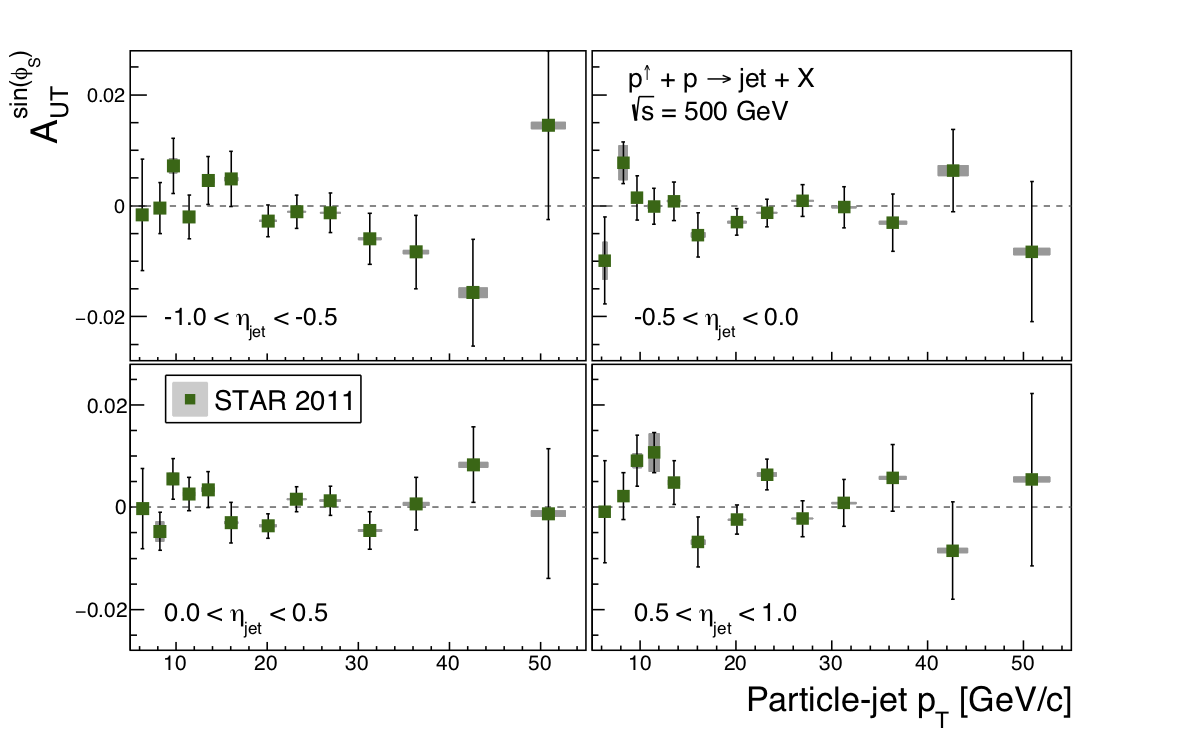
Figure 1: The inclusive-jet azimuthal transverse single-spin asymmetry as a function of jet pT in bins of jet pseudorapidity, measured relative to the polarized beam. Jet pT is shown corrected to the "particle-jet" level. A dashed line at zero is provided to guide the eye. Statistical uncertainties are shown as error bars while shaded boxes represent systematic uncertainties. An overall scale systematic of 3.5% for beam polarization uncertainty is not shown. The asymmetries are observed to be small and consistent with zero, at the current precision, over the full range of jet pT and jet pseudorapidity, suggesting a contribution below the current level of sensitivity from the twist-3 PDF at the present kinematics.
Figure 2: Collins-like Asymmetry vs. z for Low pT, jet and vs. pT for Low z

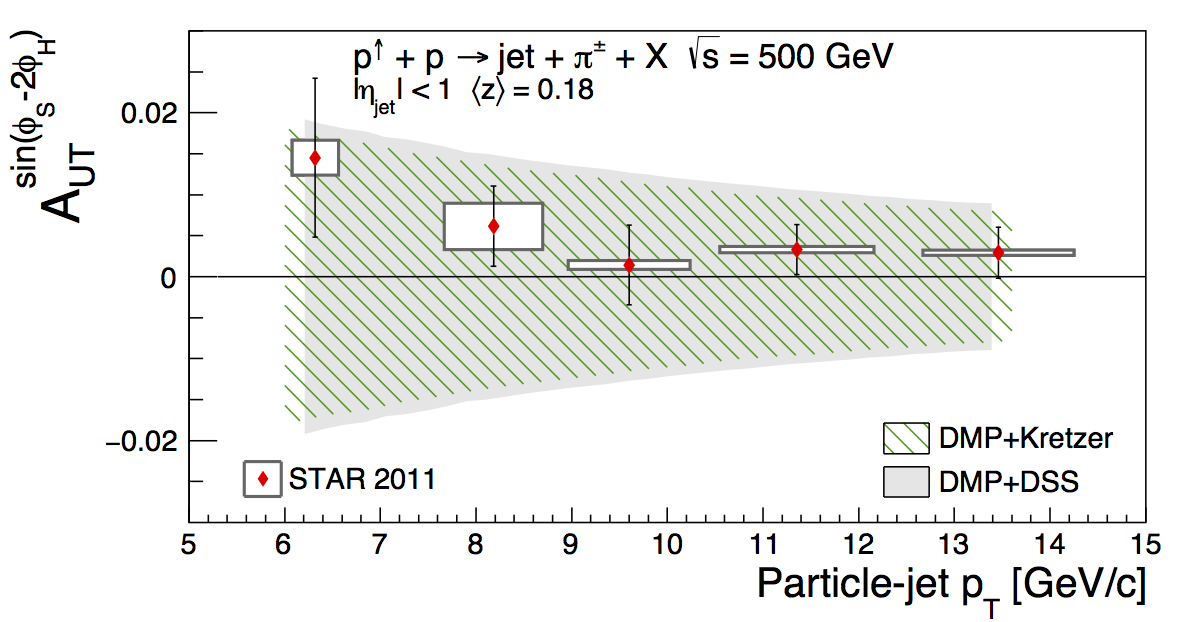
Figure 2: Collins-like asymmetries as a function of particle-jet pT for pions reconstructed with 0.1 < z < 0.3 (left) and as a function of pion z for jets reconstructed with 6 < pT < 13.8 GeV/c (right). Asymmetries are shown combining π+ and π− and integrating over the full range of jet pseudorapidity, −1 < η < 1. Statistical uncertainties are shown as error bars, while systematic uncertainties are shown as shaded error boxes. An additional 3.5% vertical scale uncertainty from polarization is correlated across all bins. Shaded bands represent maximal predictions utilizing two sets of fragmentation functions. The asymmetries are consistently small across the full range of jet pT and pion z and provide the first experimental constraints on model calculations.
Figure 3: Collins(-like) Asymmetry vs. z
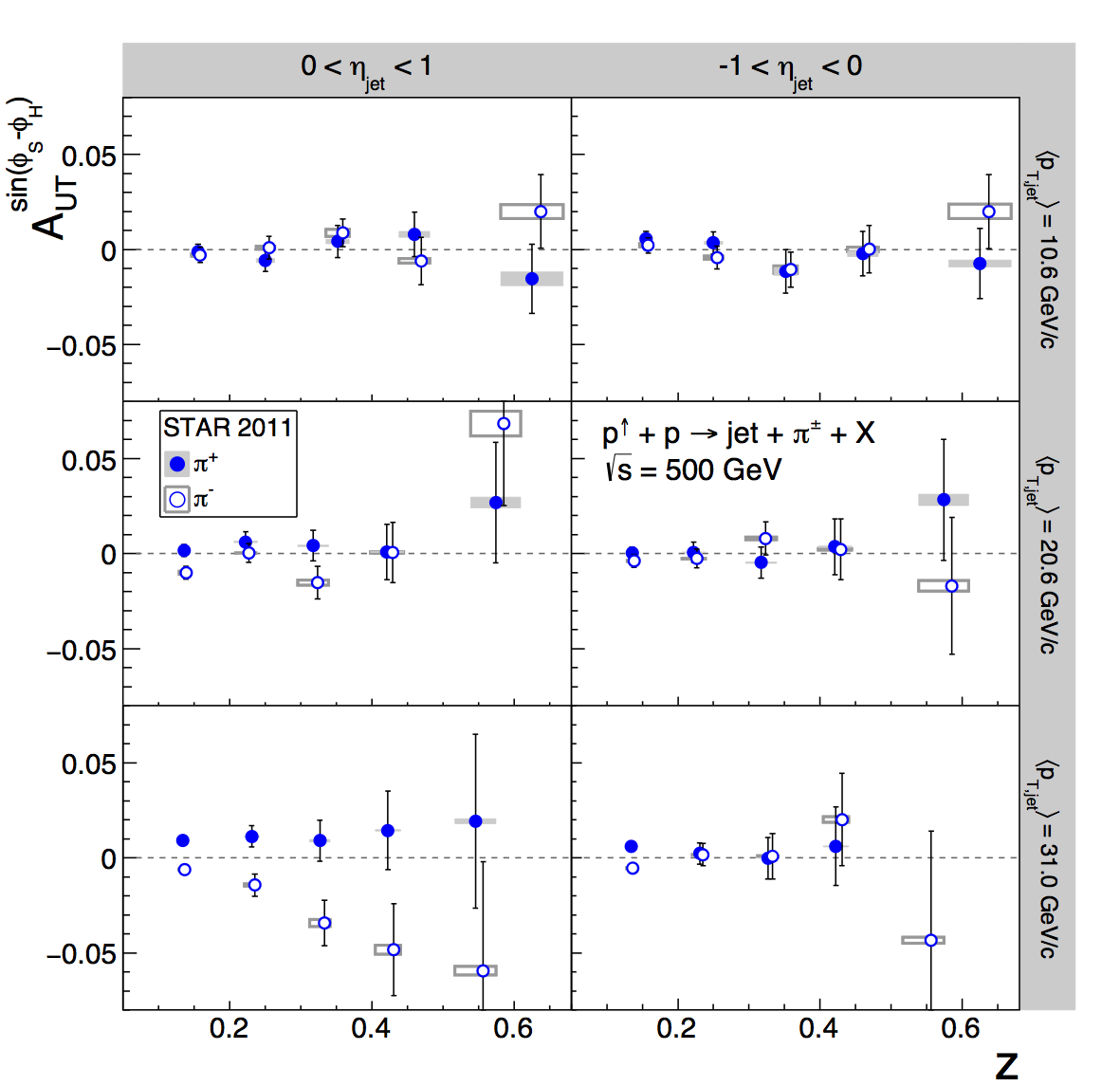

Figure 3: The (left) "Collins" and (right) "Collins-like" asymmetries are shown as a function of charged-pion z for two bins of jet psuedorapidity and three bins of jet pT. Asymmetries are shown separately for pion species. A dashed line at zero is provided to guide the eye. Statistical uncertainties are shown as error bars while shaded boxes represent systematic uncertainties. An overall scale systematic of 3.5% for beam polarization uncertainty is not shown. All Collins-like asymmetries are observed to be small and consistent with zero, at the current precision, over the full range of kinematics. The Collins asymmetries exhibit an asymmetry of 5σ signficance at high jet pT.
Figure 4: Collins(-like) Asymmetry vs. pT
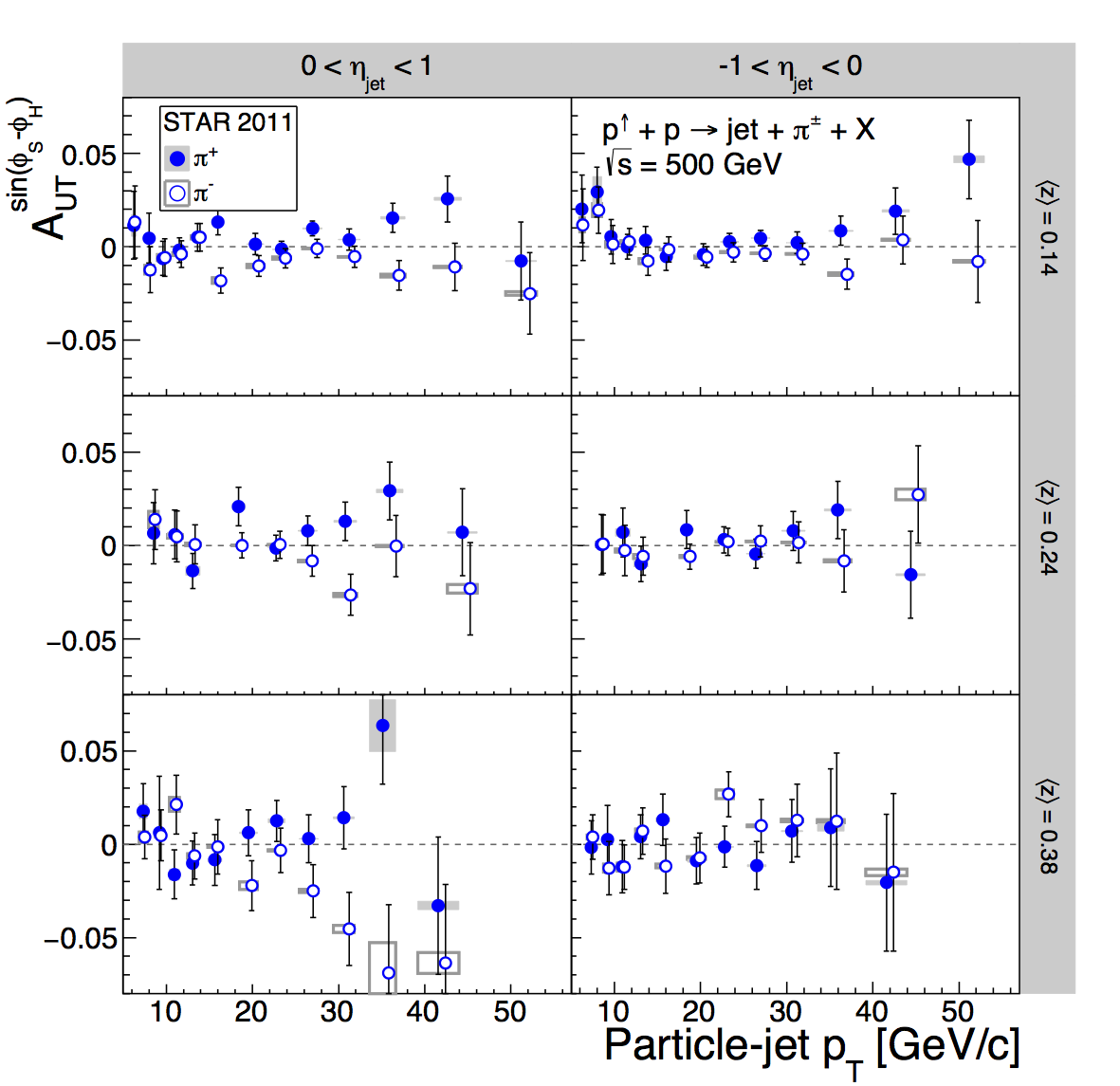
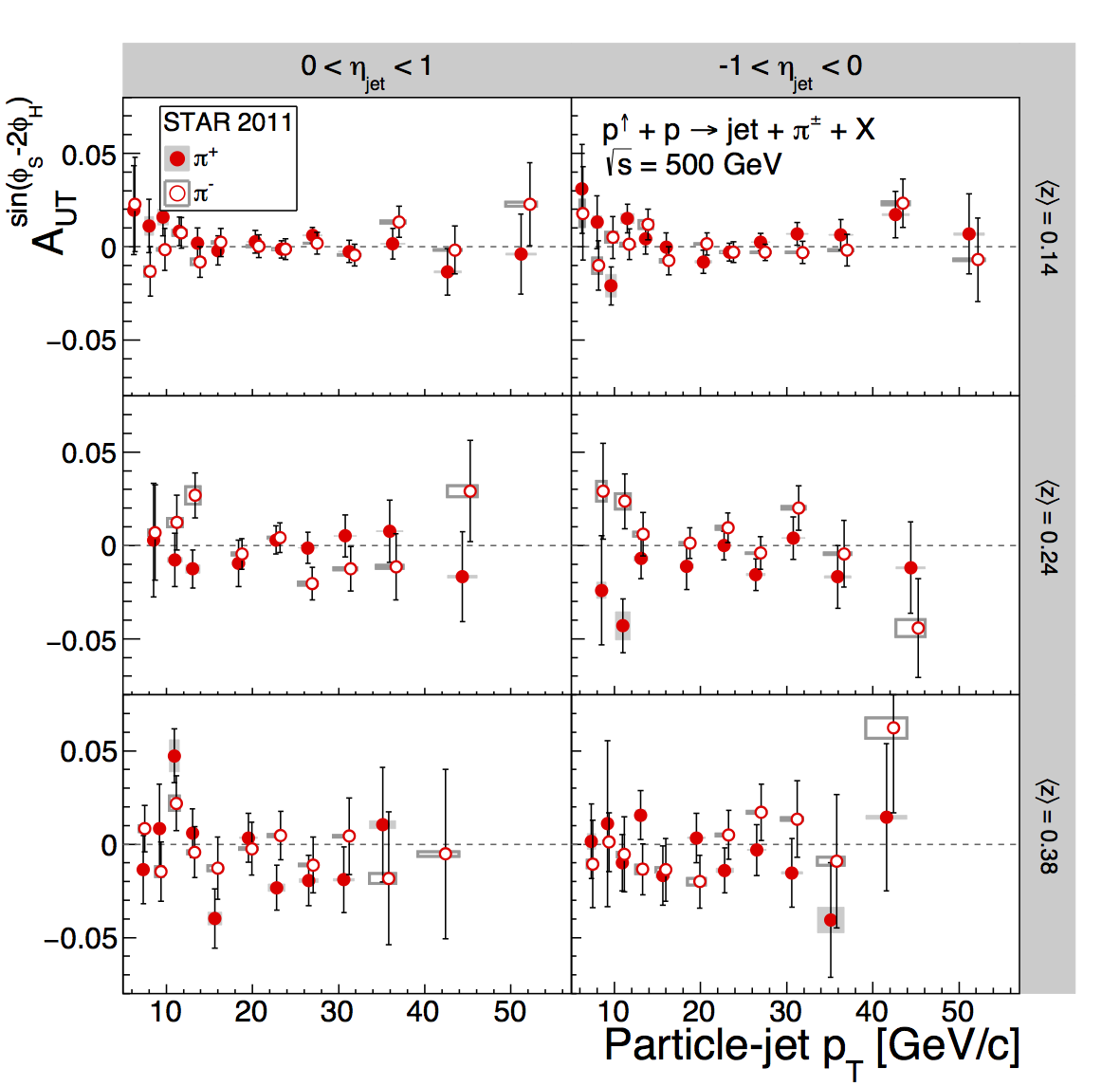
Figure 4: The (left) "Collins" and (right) "Collins-like" asymmetries are shown as a function of jet pT for two bins of jet psuedorapidity and three bins of charged-pion z. Asymmetries are shown separately for pion species. A dashed line at zero is provided to guide the eye. Statistical uncertainties are shown as error bars while shaded boxes represent systematic uncertainties. An overall scale systematic of 3.5% for beam polarization uncertainty is not shown. Collins-like asymmetries are observed to be small and consistent with zero, at the current precision, over the full range of kinematics. Collins asymmetries are non-zero for η > 0 beginning at higher jet pT, where quark-based subprocesses are expected to begin to play a significant role in the underlying partonic cross section.
Figure 5: Collins Asymmetry vs. jT
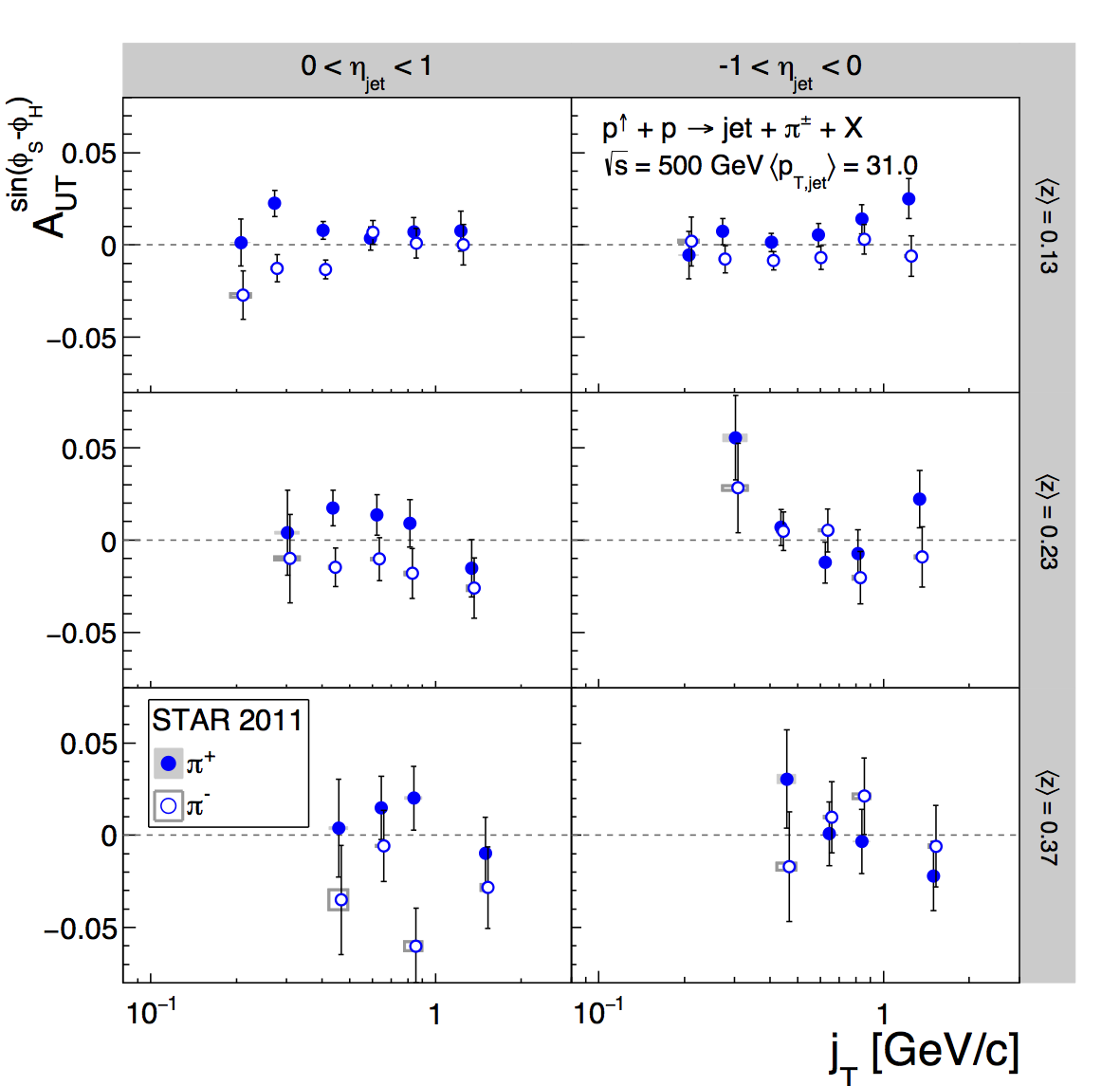
Figure 5: The "Collins" asymmetries are shown as a function of jT for two bins of jet psuedorapidity and three bins of charged-pion z. Asymmetries are shown separately for pion species. A dashed line at zero is provided to guide the eye. Statistical uncertainties are shown as error bars while shaded boxes represent systematic uncertainties. An overall scale systematic of 3.5% for beam polarization uncertainty is not shown. Collins asymmetries are non-zero for η > 0 and tend to exhibit the largest effects at lower values of jT, e.g. ~0.3 GeV/c.
Figure 6: Collins Asymmetry Model Comparison
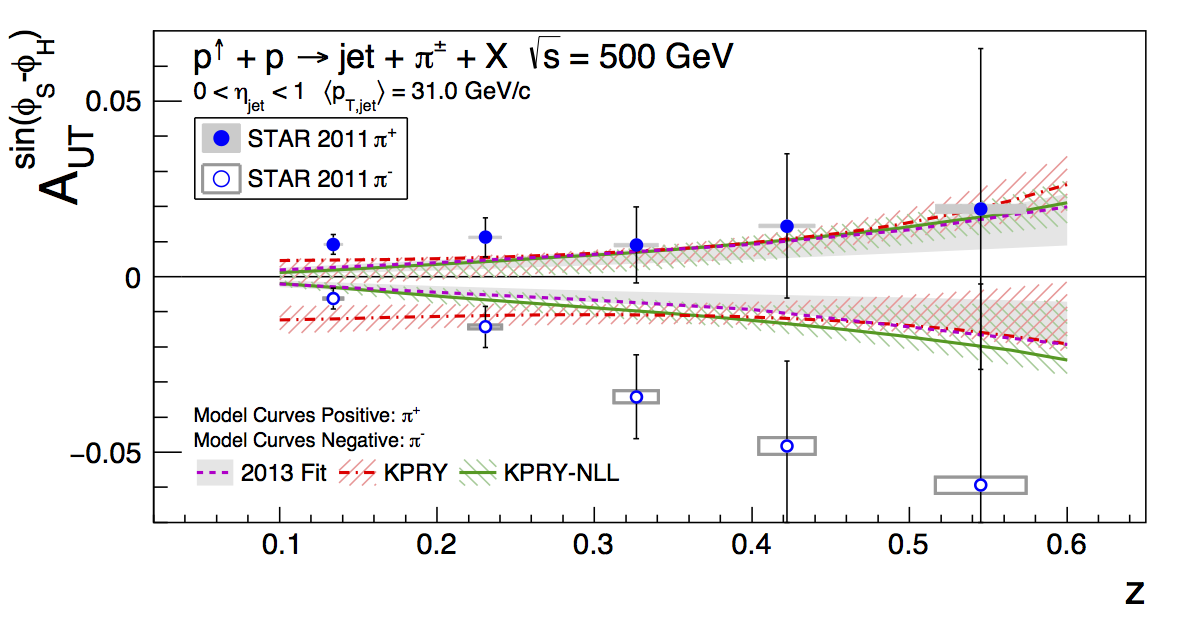
Figure 6: Collins asymmetries as a function of pion z for jets reconstructed with 22.7 < pT < 55 GeV/c and 0 < η < 1. The asymmetries are shown in comparison with model calculations. The calculations are based upon SIDIS and e+e− results and assume robust factorization and universality of the Collins function. The 2013 Fit and KPRY predictions assume no TMD evolution, while the KPRY-NLL curves assume TMD evolution up to next-to-leading-log. All predictions are shown with shaded bands corresponding to the size of their associated theoretical uncertainties. The general agreement between the data and the model calculations is consistent with assumptions of robust TMD-factorization and universality of the Collins function.
Concluding Paragraph
We have reported the first measurements of transverse single-spin asymmetries from inclusive jet and jet + π± production in the central pseudorapidity range from p↑ + p at √s = 500 GeV. The data were collected in 2011 with the STAR detector. As in previous measurements at 200 GeV, the inclusive jet asymmetry is consistent with zero at the available precision. The first-ever measurement of the "Collins-like" asymmetry, sensitive to linearly polarized gluons in a polarized proton, is found to be small and provide the first constraints on model calculations. For the first time, we observe a non-zero Collins asymmetry in polarized-proton collisions. The data probe values of Q2 significantly higher than existing measurements from SIDIS. The asymmetries exhibit a dependence on pion z and are consistent in magnitude for the two charged-pion species. For π+, asymmetries are found to be positive; while those for π- are found to be negative. The present data are compared to Collins asymmetry predictions based upon SIDIS and e+e- data. The comparisons are consistent with the expectation for TMD factorization in proton-proton collisions and universality of the Collins fragmentation function. The data show a slight preference for models assuming no suppression from TMD evolution. Further insight into these theoretical questions can be gained from a global analysis, including dihadron asymmetries and Collins asymmetries from STAR.
Paper Documents
- STAR Publication Page Entry
- Paper Drafts
- Referee Comments
- Analysis Note
- Paper Outline
Institutional Review
Analysis Code
Analysis Links
- Background Correction/PID
- Tuning the hadron radius cut
- Trigger Bias
- Run Selection
Useful Links
- Submission to PRD
- Announcement to RHIC
- Notes from PWGC Preview
- PWGC Preview Slides
- 2011 vs. 2012 "Apples-to-apples" Comparison (plot for White Paper)
- A Sanity Check for Collins
- A Jet Call update with notes on systematics
- DNP 2017 slides
- DIS 2017 slides
- DIS 2017 proceedings
- DIS 2015 slides
- DIS 2015 proceedings
- PANIC 2014 slides
- PANIC 2014 proceedings
- DNP 2013 slides
- MENU 2013 slides
- MENU 2013 proceedings
- STAR Publication Policy
- Printer-friendly version
- Login or register to post comments
